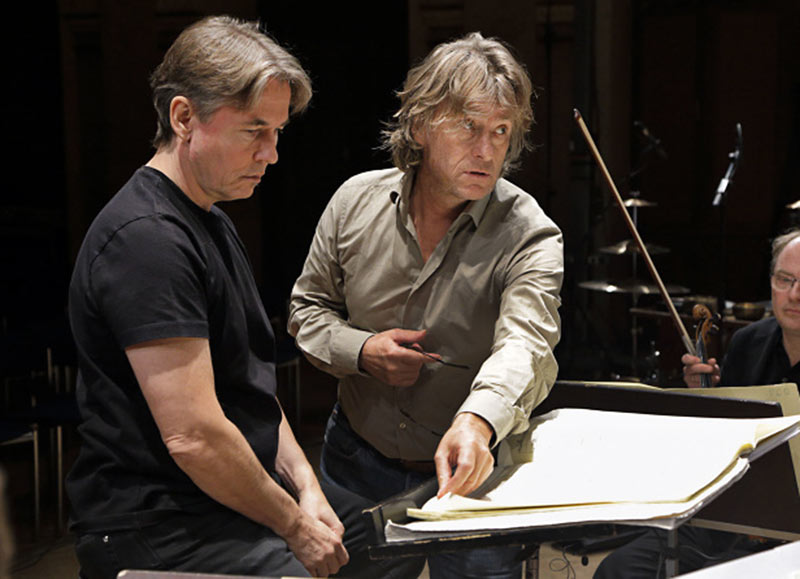 United States Hillborg, R. Strauss, Beethoven: Yefim Bronfman (piano), San Francisco Symphony / Esa-Pekka Salonen (conductor). Davies Symphony Hall, San Francisco, 28.10.2021. (HS)
United States Hillborg, R. Strauss, Beethoven: Yefim Bronfman (piano), San Francisco Symphony / Esa-Pekka Salonen (conductor). Davies Symphony Hall, San Francisco, 28.10.2021. (HS)

Anders Hillborg – Kongsgaard Variations
R. Strauss – Sonatina No.2 in E-flat major for 16 Wind Instruments
Beethoven – Piano Concerto No.3 in C minor
As the San Francisco Symphony warmed up for the first of this week’s concerts, I did a double-take at the pianist sitting at the back. He looked an awful lot like Yefim Bronfman, who generally sits at a piano at the front of the orchestra. And he would do so this day as the soloist for the Beethoven Concerto No.3 in C minor, to be played after intermission.
Indeed, he had been enlisted to play a bit of the slow movement from Beethoven’s Piano Sonata No.32 as a prelude to composer Anders Hillborg’s Kongsgaard Variations, a piece based on that very theme. The Swedish composer wrote the variations in 2006 for string quartet. His version for string orchestra made its debut earlier this year in Norway, and this was the San Francisco premiere.
There is also a local connection to the work. John Kongsgaard, a celebrated Napa Valley wine producer who supports the arts with a chamber music series and more than a few commissions, tasked Hillborg with writing the piece for Arietta wines, a spinoff from Kongsgaard’s eponymous label. The two measures pictured on the Arietta label from the sonata’s slow movement, which Beethoven titled ‘Arietta’, inspired Hillborg to use the entire theme for a set of modern variations.
The piece was magical as a quartet, but the colors and texture possible in a full string ensemble give it extra depth. After Bronfman’s beautifully shaped walk through Beethoven’s leisurely paced theme, the new piece’s high-lying sustained notes played by the violins seemed to rise from the final chords like wisps of a cloud. It made a seamless segue.
The first couple of variations toy gently with the chordal accompaniment rather than the melodic elements, creating a dreamy atmosphere. Hillborg takes pleasure in distorting Beethoven’s music. Without descending into grating dissonance, the music floats in a slowly swirling fog; then out of it emerges an extended solo for the principal violin, rife with double stops like a Bach partita, echoed later by the principal viola.
The melody finally arrives about halfway through the 16-minute piece, each note starting softly and crescendoing quickly before the next, a disconcerting effect like a recording played backwards.
After a development section that threatens to descend into chaos, Beethoven’s theme finally emerges in its original form. It even gains majesty from the sound of sustained strings as opposed to the piano’s quick decay on each note. At the end, Hillborg layers on waves of glissandos over the final chords before it all fades out on a lovely major chord.
Conductor Esa-Pekka Salonen made it all unfold with purpose but without any noticeable strain. Completing a season-opening five consecutive weeks of concerts, it is clear that he and the musicians are quickly developing a close bond.
Next it was the winds’ turn, with a 16-piece woodwind and French horn ensemble playing Richard Strauss’s Sonatina No.2, finished in 1944 as World War II was winding down. Neither opera nor tone poem, this is one of those Strauss pieces now seldom programmed (these are the San Francisco Symphony’s first performances). The piece is steeped in musical language reminiscent of Der Rosenkavalier: lighthearted, all surface and little depth. Written around the same time as Metamorphosen (for strings), a work that impresses with its depth, this was more a jolly romp that reminded me of band concerts in the park. The composer nicknamed the work Fröhliche Werkstatt (‘Happy Workshop’), and the expert ensemble made it sound exactly like that.
The other shoe from the Hillborg piece that started the program dropped after intermission with a breathtaking performance of the Beethoven piano concerto, gorgeously shaped by Salonen and executed by Bronfman with his usual grace, precision and ability to conjure just what the composer intended.
The orchestra began with a serious statement, but Salonen’s lively pace kept it from the heavy feeling of so many Beethoven C-minor works. Bronfman’s entrance sparkled, the rapid-fire scales emerging from the orchestra’s final chord like a Fourth of July sparkler. Orchestra and soloist found balances of volume and unity of articulation that made the whole piece come alive.
Bronfman’s extended cadenza played with all the elements of the first movement, foreshadowing a slow movement that was especially fine. Perhaps heightened by the explorations of the Hillborg piece earlier, the pianist’s opening statement of the noble theme (in the same E-flat major as the sonata movement that provided the base of the variations in the first half of the concert) set the tone for an unhurried tempo that allowed the give-and-take with different sections of the orchestra to bloom naturally.
The Rondo finale, its recurring tune so deftly executed by Bronfman that it felt like a long-lost and much-missed friend every time it returned, brought things to a lively close.
Even though the concert had gone on for more than two hours, Bronfman sent the audience home with a gorgeous Chopin encore. Nocturne Op.27 No.2 began with a whisper and gained momentum as it wafted through its six minutes, Salonen perched on a back section riser, listening as intently as the rest of us.
Harvey Steiman
